The Problem: Voice AI Agent Deployment Takes Too Long
Speed Up Your Voice AI Agent Testing from Hours to Minutes
Setting up a voice AI agent typically takes 4-6* hours of manual work - gathering company information, building knowledge bases, and configuring settings. This automation speeds up that process to just minutes by automatically processing your client on-boarding data and creating a contextually aware voice agent ready for further customisation, specific to your client's needs. It's designed as a deployment assistant, not a complete solution. The agent you get needs human review, testing, and refinement before going live, but it gives you a solid starting point based on proven templates from successfully deployed agents.
*: This is an optimistic contextual estimate for a 'simple' agent modelled on a proven, production-tested agent.
Who Should Consider This Approach?
This approach is designed for business leaders, project managers, and development teams who regularly deploy voice AI agents and want to speed up their initial setup process. It's particularly valuable if you're working with standard agent types (like customer support, booking, or messaging agents) and want to reduce the manual work involved in getting agents ready for testing and customisation to the customer's specific needs.
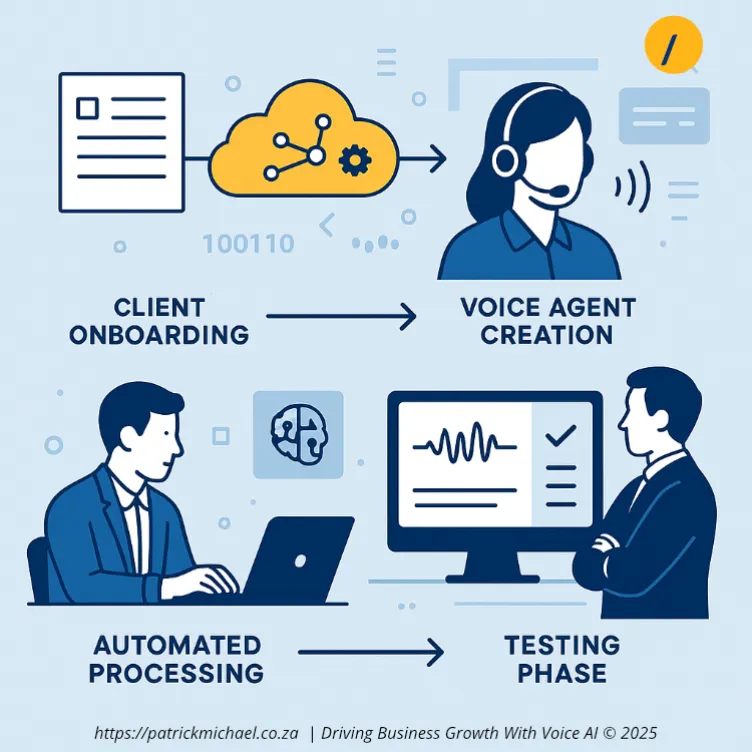
What Problem Does This Actually Solve?
The Current Manual Process is Time-Intensive
When you deploy a new voice AI agent, someone typically needs to:
- Manually gather company information from websites and documents
- Create and structure knowledge bases with FAQs and service details
- Configure agent settings, voice preferences, and response guidelines
- Test and refine the agent before it can handle real customer interactions, tailored to specific company requirements
This process usually takes 4-6 hours* per agent and requires technical expertise to ensure consistency and quality.
*: This is an optimistic contextual estimate for a 'simple' agent modelled on a proven, production-tested agent.
The Business Impact of Slow Deployment
Slow voice agent deployment creates several business challenges:
- Resource Bottlenecks: Technical teams become overwhelmed with setup tasks
- Inconsistent Quality: Manual processes lead to variations in agent performance
- Delayed Time-to-Market: Longer setup times mean slower roll-outs
- Higher Costs: More manual work means higher development costs
What This Tool Does Differently
This automation tool processes client on-boarding information and automatically creates a contextually aware voice agent that understands your business. Instead of starting from scratch. You get an agent that already knows about your services, and company information - ready for testing and refinement.
How Does the Process Work?
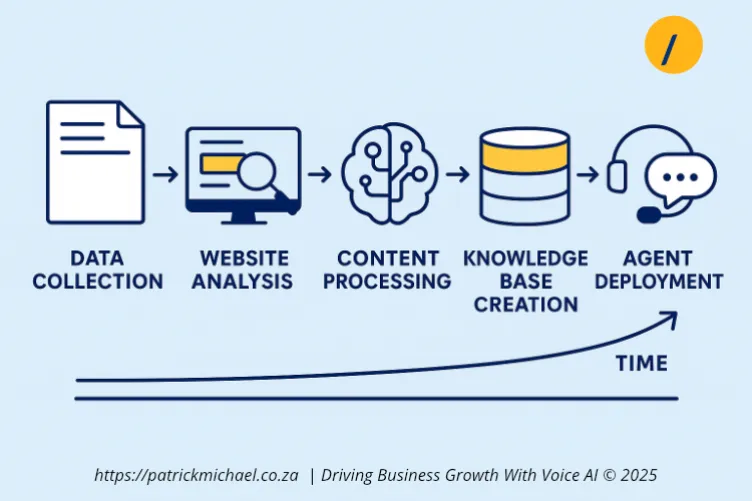
The Five-Step Automated Process
The system follows a straightforward five-step process that requires minimal human input:
Step 1: Data Collection
When a client submits their on-boarding form (company name, website, contact details, preferences), the system automatically captures and organises this information.
Step 2: Website Analysis
The system scans the client's website to discover relevant pages about services, pricing, FAQs, and company information. It identifies the most important content for the voice agent to understand.
The automation uses the FireCrawl API. I felt it prudent to test the available FireCrawl methods:
- Scrape: Scrapes individual pages (tested)
- Batch scrape: Scrapes a batch of URLs at one time (busy testing)
- Crawl: Crawls a given URL (TODO)
- Extract: Extracts data using agent process (completed initial rudimentary testing)
Step 3: Content Processing
AI technology extracts and processes the website content, organizing it into structured information that a voice agent can use to answer customer questions accurately.
Step 4: Knowledge Base Creation
The system creates a comprehensive knowledge base using proven templates, ensuring the agent has consistent access to company information, services, and common customer queries.
Step 5: Agent Deployment
The voice agent is configured and deployed on the VAPI platform with company-specific settings, ready for human testing and refinement.
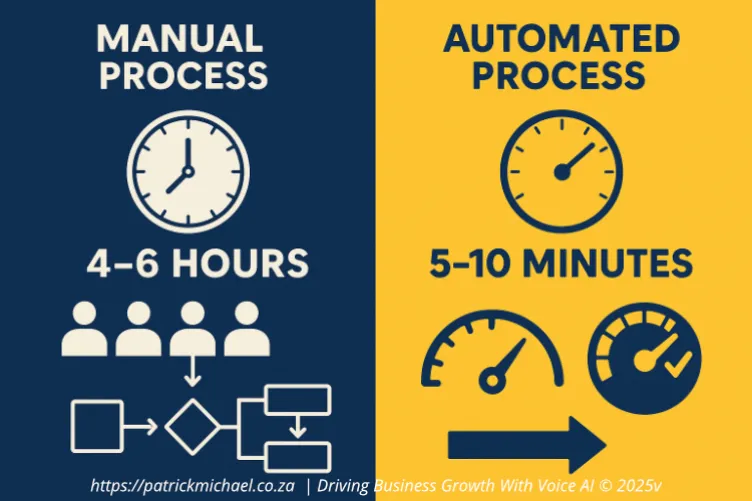
Time Comparison
- Manual Process: 4-6 hours of skilled labour
- Automated Process: 5-10 minutes of automated processing
- Human Review: Additional time needed for testing and refinement
What Do You Actually Get?
A Contextually Aware Voice Agent Ready for Testing
The output is a voice AI agent that understands your business context and can handle basic customer interactions. It knows about your services, pricing structure, business hours, and can answer common questions.
Query_tool and Knowledge Base (KB) Setup
The process includes:
- Uploading the KB file to VAPI
- Creating the custom query_tool with knowledge_base that uses the KB file
Complete Setup Package
Along with the agent, you receive:
- Structured Knowledge Base: Organised company information in an AI-readable format, including a custom VAPI query_tool and knowledge_base that uses the KB file
- Configuration Files: All technical settings and preferences applied
- Testing Environment: Agent deployed and ready for evaluation
- Documentation: Setup details and configuration information
Important: What You Don't Get
This is not a production-ready agent. What you receive is a well-configured starting point that requires human testing, validation, and refinement. Think of it as a smart first draft that saves you hours of initial setup work.
Quality and Consistency
Because the system uses proven templates and standardised processes, every agent starts with the same high-quality foundation. This eliminates the variations that come with manual setup and ensures consistent performance across different deployments.
What Are the Requirements and Limitations?
Prerequisites for Success
This tool works best when you meet these requirements:
Critical Requirements
- Proven Agent Category: Your agent must fit into a category that has been successfully deployed before (customer support, booking, messaging, etc.)
- Quality Website Content: Your business website needs clear information about services, pricing, and company details
- Human Oversight: You need team members who can test, validate, and refine the agent
- Realistic Expectations: Understanding that this creates a starting point, not a finished product
What This Tool Cannot Do
It's important to understand the limitations:
- Not Universal: Only works with proven agent templates, not custom or experimental agent types
- Not Production-Ready: Agents need human testing and refinement before going live
- Not Self-Improving: Requires human input for quality control and customization
- Not Error-Free: All content and responses need human validation for accuracy
The Human-in-the-Loop Requirement
Success depends on having qualified team members who can:
- Test the agent thoroughly before deployment
- Validate information accuracy and relevance
- Refine responses and behaviour for your specific needs
- Monitor performance and make ongoing improvements
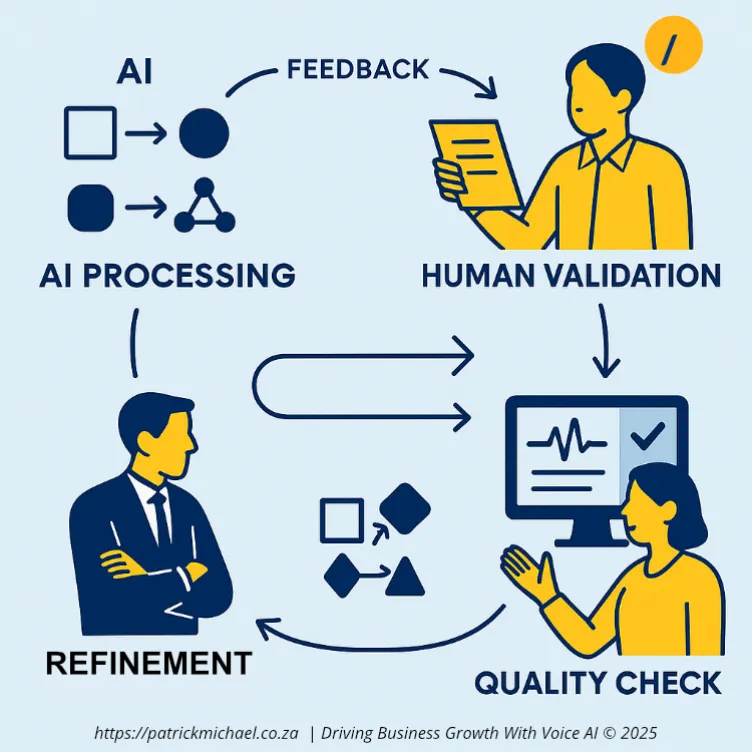
What Are the Business Benefits?
Immediate Time and Cost Savings
The most obvious benefit is time reduction - from 4-6 hours to minutes for initial setup. This translates to:
- Lower Development Costs: Less skilled labour time required per agent
- Faster Deployment: Agents ready for testing much sooner
- Resource Efficiency: Technical teams can focus on refinement rather than setup
- Scalability: Ability to handle multiple agent deployments simultaneously
Quality and Consistency Improvements
Automated setup reduces human error and ensures consistent quality:
- Standardised Process: Every agent starts with the same high-quality foundation
- Comprehensive Coverage: Automated discovery ensures no important content is missed
- Professional Presentation: Consistent formatting and organization
- Reduced Variations: Less dependence on individual developer preferences
Strategic Business Impact
Beyond immediate savings, this approach enables:
- Faster Market Response: Quicker agent deployment for new opportunities
- Better Resource Allocation: Human expertise focused on high-value activities
- Improved Customer Experience: More consistent agent performance across deployments
- Competitive Advantage: Faster time-to-market for voice AI solutions
ROI Calculation Example
If you deploy 10 agents per month and save 4 hours per agent at $75/hour loaded cost, you save $3,000 monthly in development costs alone. Factor in faster time-to-market and improved quality, and the ROI becomes significant.
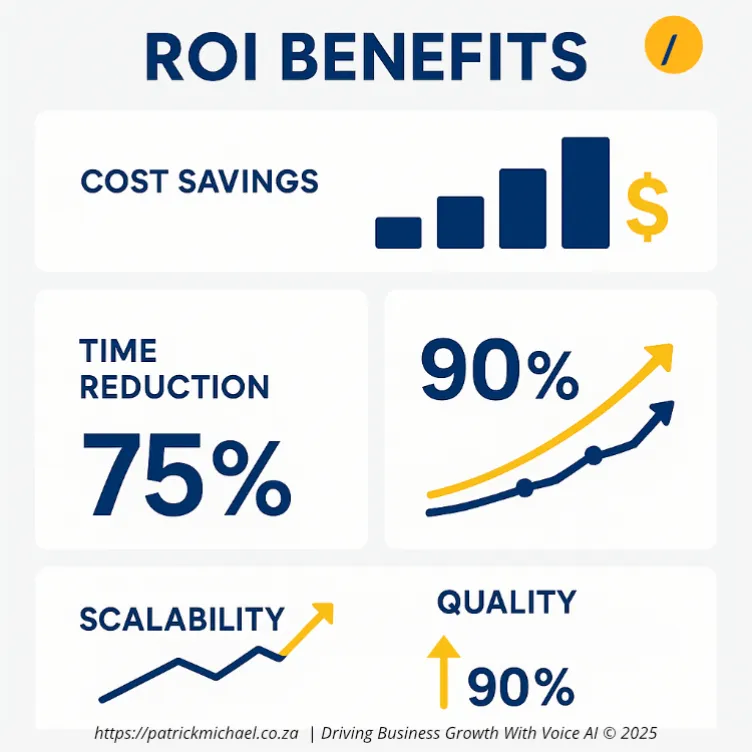
How Do You Implement This?
Technical Requirements
Implementation requires access to several services and platforms:
- VAPI Platform: For voice agent hosting and management
- Make.com | n8n: For workflow automation and orchestration
- FireCrawl API: For website content extraction
- OpenAI API: For content processing and analysis
- GitHub and GitLab: For template management and version control
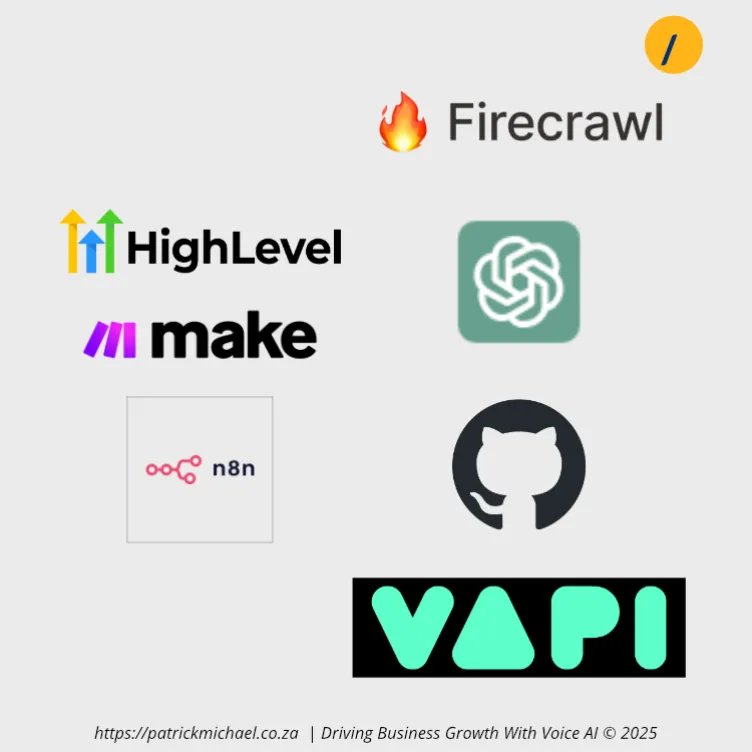
Implementation Steps
The implementation process involves:
- Platform Setup: Configure accounts and API access for required services
- Workflow Configuration: Set up the automation workflow in
Make.comorn8n - Template Preparation: Ensure you have proven agent templates for your use cases
- Testing and Validation: Run pilot deployments to validate the process
- Team Training: Train staff on testing and refinement procedures
Best Practices for Success
To maximise the value of this approach:
- Start Small: Begin with a pilot program using one agent type
- Document Everything: Track what works and what needs refinement
- Plan for Human Review: Always budget time for testing and validation
- Monitor Quality: Establish metrics to measure agent performance
- Iterate and Improve: Continuously refine your templates and processes
Critical Success Factor
Remember: This tool accelerates the initial setup phase, but human expertise remains essential for quality control, testing, and refinement. Plan your implementation with adequate human oversight built in.
Setting Realistic Expectations
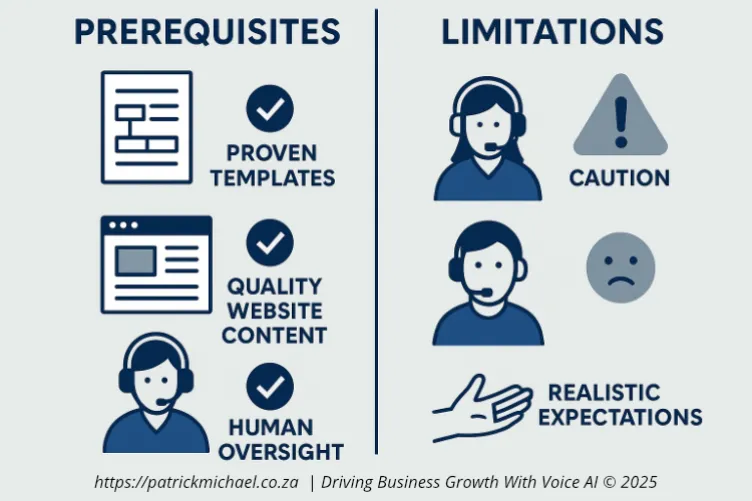
What Success Looks Like
Successful implementation means:
- Consistently faster initial agent setup (hours to minutes)
- Higher quality starting points for agent development
- More time available for testing and refinement
- Reduced dependency on individual developer expertise for setup
- Ability to handle multiple agent deployments efficiently
Common Misconceptions to Avoid
This tool is not:
- A complete solution: It's a deployment assistant, not a replacement for human expertise
- Universally applicable: Only works with proven agent categories and quality input data
- Set-and-forget: Requires ongoing human oversight and refinement
- Perfect out-of-the-box: All outputs need validation and customization
'The goal isn't to replace human expertise, but to amplify it by eliminating repetitive setup tasks and providing a high-quality starting point for voice AI development.'
Making the Most of This Approach
To maximise value:
- Treat it as a time-saving tool, not a complete solution
- Invest in quality templates based on your successful agents
- Maintain strong human oversight and validation processes
- Use the time savings to focus on higher-value activities like testing and optimization
- Continuously improve your templates and processes based on results
Key Takeaways
- This automation tool speeds up voice AI agent setup from hours to minutes, creating agents ready for testing
- It works best with proven agent categories and requires human oversight for quality control
- The output is a well-configured starting point that needs human testing and refinement before production use
- Business benefits include time savings, cost reduction, and improved consistency in agent deployment
- Success requires realistic expectations and proper human oversight throughout the process
- Bottom Line: This is a valuable deployment assistant that accelerates setup while maintaining the need for human expertise in testing and refinement
TL;DR
This automation tool processes client onboarding data to rapidly create contextually aware voice AI agents ready for testing. It reduces initial setup time from 4-6 hours to minutes by automatically gathering company information, building knowledge bases, and configuring agent settings. The output requires human testing and refinement before production use, but provides a high-quality starting point based on proven templates. Best suited for standard agent types with proper human oversight.
Additional Resources
Note: Links to certain sites such as VAPI, Make.com and Eleven Labs, are affiliate links. I may earn commission off these links. Please support me.
Helpful Links:
- TODO
Subscribe
Explore the practical possibilities of AI for your business. Subscribe to our newsletter for insights and discussions on potential AI strategies and how they are adopted.
References
This article is made possible due to the following excellent resources:
TODO
Recent Articles
The following articles are of interest:
Add new comment